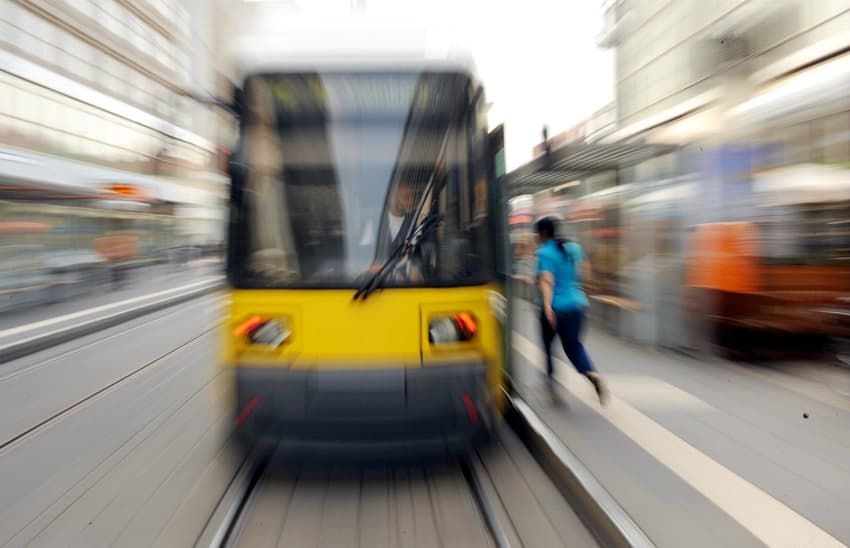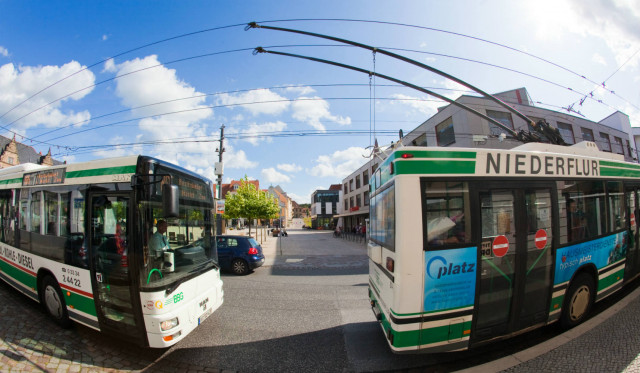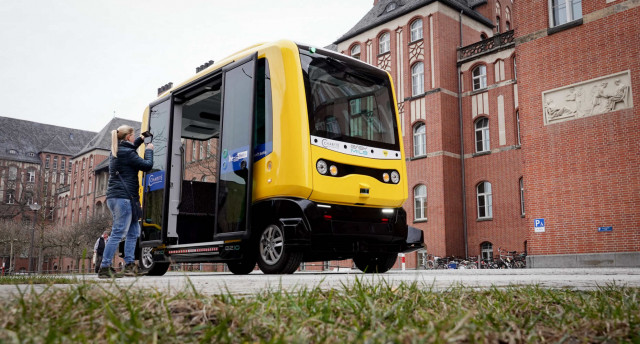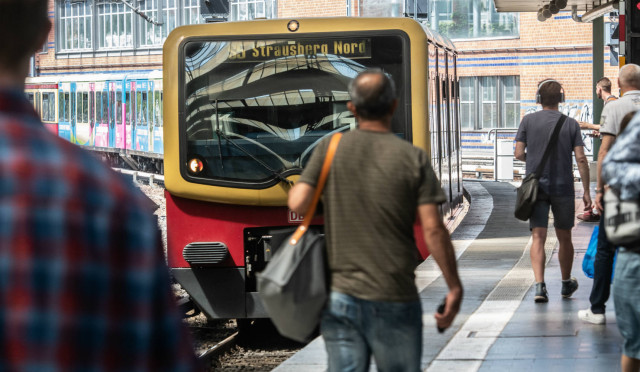Here's how Berlin plans to radically overhaul its public transport system

Berlin is planning an overhaul of its aged, over-stretched public transport network. From trams in the west to self-driving busses, we've boiled down the transport department's 350-page white paper to give you everything you need to know about the new masterplan.
It is no secret that Berlin's public transport infrastructure has been running on a wing and a prayer for years. While much attention is paid to the fact that the capital of Europe's largest economy still does not have a modern international airport, the inner city transport infrastructure is itself a major headache for the indebted city.
In an interview with The Local at the end of last year, the Berlin Passenger Association (IGEB) described the the capital's public transport system as "in crisis".
Addressing the increasing number of delays on the U-Bahn lines, the IGEB's Jens Wieseke explained that the average U-Bahn train is three decades old - the age at which a train is normally put into retirement.
“On the U55 line they have started using trains again that were sold to North Korea and were put out of service two decades ago. I might want to see these when I visit a museum, but not on my way to work,” Wieseke said.
It is not just out-dated vehicles that are putting a strain on the system, though. Sharp population growth plus a tourism boom mean every more people are criss-crossing the city. And, with authorities expecting a further 26 percent growth in passenger numbers by 2030, the trend doesn't seem likely to stop.
For years, Berlin has been criticized for underfunding its public transport network, as politicians try to make a dent in its huge public debt. But a 350-page white paper on public transport, released by the city transport department earlier this week, shows that a dramatic reversal is to take place over the next five years. Huge investment is planned in both modernizing and extending the infrastructure.
Berlin's deputy mayor, Ramona Pop (Greens), said on Monday when the white paper was published that the city was planning to build 12 new residential districts for 100,000, many of which will be constructed on the city outskirts.
"Considering that the city is growing, what we don't want is that people who live on the outskirts start using cars, for that we need better public transport connections."
Buses: more frequent, more eco-friendly
It might not be sexy, but the biggest changes in the transport network are set to arrive on the road rather than on the tracks. One of the key proposals in the paper is that a bus will arrive every ten minutes on every bus line in the city. While this is already the case for most lines in the inner city, it will ensure that Berliners living outside the ring will have access to a much more reliable bus network.
As of August 2020, all bus lines will travel at least every ten minutes on weekdays till 8pm and on Saturdays from 10am until 6pm.
New metro bus and express bus routes are also to be introduced. Metro buses (such as the M11) travel 24-hours a day on some of the city's busiest routes and have proved increasingly popular in recent years. In response, the city plans to add nine new lines.
The same goes for the express buses (e.g .the X7 to Schönefeld Airport). These make few stops and thus whisk people around town at a much faster pace. New routes will including the X59 from Französisch Buchholz to Osloer Straße and the X71 from Dahlem Dorf to the new airport.

Trolley buses, such as these ones in the nearby town of Eberswalde, may soon be introduced in Berlin. Photo: DPA
The technology on the bus routes is also set for a radical overhaul. By 2030 every single bus operating in the city will run on electricity, the white paper states. To that end the Berlin Transport Company (BVG) has been instructed to buy 120 e-busses over the next four years. Each of them will be 12 metres in length and will be charged at the depots before they head out.
The build up of the fleet will then continue apace until 2030, when 1,500 e-buses will be in service. One potential obstacle to this ambitious environmental goal is the fact that there is still no electric version of the double-decker bus.
A major pillar of the flip to electricity will be 240-kilometres of overhead cables which will power trolley buses on certain routes. The overhead cables will not cover entire routes but are envisioned as a supplementary source of energy to charging points at bus depots.
Self-driving buses?
Intriguingly, the white paper also proposes that trials be carried out on introducing self-driving minibuses on some routes.
Since March driver-less buses have in fact already been in operation on the the grounds of the Charite hospital. The buses carry up to eleven passengers and travel at a top speed of 12 kilometres an hour. The city hopes that, if the €4.1 million project is successful, the buses can be used to cover blind spots in the city transport network.
 Photo: DPA
Photo: DPA
Trams to conquer the West
Trams in Schöneberg and Charlottenburg are unthinkable for younger Berliners. Whereas the tram lines were ripped up in West Berlin, they remained in use in the East and are still a silent signal for which side of the wall you are on.
But that looks set to change, with the city government planning major tram projects in the west of the city.
First lines will be built linking eastern neighbourhoods with the west. One of the first of these will cover a notorious black hole in the transport network: a tram from Hermannplatz to Warschauer Straße will link Friedrichshain and Neukölln, meaning an end to awkward detours along the Ringbahn. The provisional opening date for that route is 2025. Another route that is sure to be packed will link the Kulturforum just south of Tiergarten to Alexanderplatz.
Another dozen or so lines are to be built before 2030, many of which are entirely in the west. The headline build here is a tram travelling from Potsdamer Platz down to Rathaus Steglitz in the southwest of the city.
Extending the U-Bahn
Ramona Pop signalled on Monday that she supports investment in the city's U-Bahn lines, saying that lines should be extended "as it is a mode of transportation that reduces traffic on the street, has a large capacity and operates independent of the weather."
Nonetheless, concrete proposals on new U-bahn projects are notable by their absence, and limited to vague plans for line extensions which were already on the table.
The U6 is to be extended onto the grounds of Tegel Airport, where a tech centre will be opened after the airport's closure. Likewise a costly project to tunnel the U7 through to the new BER airport in the south is being considered. The U8 could also stretch further north to the rundown Märkisches Viertel.
There will be a noticeable difference in terms of the regularity of train arrivals. By 2023, they are set to arrive every 3.3 minutes instead of every four minutes. And the trains are also supposed to get longer to accompany the ever increasing passenger numbers.
At the moment, the BVG's longest trains are 40 metres, but the transport wants to extend it to 50 metres. So no more sudden sprints down platforms to leap on the back of a Kurzzug.
Shiny new S-Bahn
Berlin’s suburban rail system will see a major improvement with the construction of a second north-south line. The line will be completed in stages. The first stage, from Gesundbrunnen to Hauptbahnhof will be ready in 2020, but the second and the irs stages (through Potsdamer Platz and Yorckstraße/Großgörschenstraße aren’t scheduled to be completed until after 2030.
The plan additionally sets out that the trains on the S-Bahn are to be replaced between 2021 and 2023. On the Ringbahn the S41/S42 trains will be extended to eight carriages to cope with higher passenger numbers.

'Way too late'
The Berlin Passenger Association seem to be very encouraged by the white paper. Wieseke from the IGEB told The Local on Wednesday that, while they were still going through the details of the plan, they found it to be “a very positive development.”
The decision in the white paper to focus on trolley buses and extending the tram network and to pay less attention to extending the underground system was certainly the right one, he said.
For reasons of both costs and speed of building up the infrastructure, overground public transport has to be the city’s priority he explained.
One weakness that he identified in the document was a lack of urgency given to constructing tram networks in Spandau in the far west of the city.
“The plan is to set up a trolley bus network there. That might be good from an environmental perspective, but trams are needed there to cope with the demand,” he said.
Peter Neumann, a transport journalist at the Berliner Zeitung said that the white paper was giving Berliners almost everything they had asked for for years. "Dreams are coming true," he commented.
But he added that people would need massive amounts of patience in waiting for the projects to be realized.
"The backlog is enormous... planners in Berlin have been confronted by years of austerity. It is right things are about to start moving. The plan is good - but it is coming way too late."
Comments
See Also
It is no secret that Berlin's public transport infrastructure has been running on a wing and a prayer for years. While much attention is paid to the fact that the capital of Europe's largest economy still does not have a modern international airport, the inner city transport infrastructure is itself a major headache for the indebted city.
In an interview with The Local at the end of last year, the Berlin Passenger Association (IGEB) described the the capital's public transport system as "in crisis".
Addressing the increasing number of delays on the U-Bahn lines, the IGEB's Jens Wieseke explained that the average U-Bahn train is three decades old - the age at which a train is normally put into retirement.
“On the U55 line they have started using trains again that were sold to North Korea and were put out of service two decades ago. I might want to see these when I visit a museum, but not on my way to work,” Wieseke said.
It is not just out-dated vehicles that are putting a strain on the system, though. Sharp population growth plus a tourism boom mean every more people are criss-crossing the city. And, with authorities expecting a further 26 percent growth in passenger numbers by 2030, the trend doesn't seem likely to stop.
For years, Berlin has been criticized for underfunding its public transport network, as politicians try to make a dent in its huge public debt. But a 350-page white paper on public transport, released by the city transport department earlier this week, shows that a dramatic reversal is to take place over the next five years. Huge investment is planned in both modernizing and extending the infrastructure.
Berlin's deputy mayor, Ramona Pop (Greens), said on Monday when the white paper was published that the city was planning to build 12 new residential districts for 100,000, many of which will be constructed on the city outskirts.
"Considering that the city is growing, what we don't want is that people who live on the outskirts start using cars, for that we need better public transport connections."
Buses: more frequent, more eco-friendly
It might not be sexy, but the biggest changes in the transport network are set to arrive on the road rather than on the tracks. One of the key proposals in the paper is that a bus will arrive every ten minutes on every bus line in the city. While this is already the case for most lines in the inner city, it will ensure that Berliners living outside the ring will have access to a much more reliable bus network.
As of August 2020, all bus lines will travel at least every ten minutes on weekdays till 8pm and on Saturdays from 10am until 6pm.
New metro bus and express bus routes are also to be introduced. Metro buses (such as the M11) travel 24-hours a day on some of the city's busiest routes and have proved increasingly popular in recent years. In response, the city plans to add nine new lines.
The same goes for the express buses (e.g .the X7 to Schönefeld Airport). These make few stops and thus whisk people around town at a much faster pace. New routes will including the X59 from Französisch Buchholz to Osloer Straße and the X71 from Dahlem Dorf to the new airport.

Trolley buses, such as these ones in the nearby town of Eberswalde, may soon be introduced in Berlin. Photo: DPA
The technology on the bus routes is also set for a radical overhaul. By 2030 every single bus operating in the city will run on electricity, the white paper states. To that end the Berlin Transport Company (BVG) has been instructed to buy 120 e-busses over the next four years. Each of them will be 12 metres in length and will be charged at the depots before they head out.
The build up of the fleet will then continue apace until 2030, when 1,500 e-buses will be in service. One potential obstacle to this ambitious environmental goal is the fact that there is still no electric version of the double-decker bus.
A major pillar of the flip to electricity will be 240-kilometres of overhead cables which will power trolley buses on certain routes. The overhead cables will not cover entire routes but are envisioned as a supplementary source of energy to charging points at bus depots.
Self-driving buses?
Intriguingly, the white paper also proposes that trials be carried out on introducing self-driving minibuses on some routes.
Since March driver-less buses have in fact already been in operation on the the grounds of the Charite hospital. The buses carry up to eleven passengers and travel at a top speed of 12 kilometres an hour. The city hopes that, if the €4.1 million project is successful, the buses can be used to cover blind spots in the city transport network.
 Photo: DPA
Photo: DPA
Trams to conquer the West
Trams in Schöneberg and Charlottenburg are unthinkable for younger Berliners. Whereas the tram lines were ripped up in West Berlin, they remained in use in the East and are still a silent signal for which side of the wall you are on.
But that looks set to change, with the city government planning major tram projects in the west of the city.
First lines will be built linking eastern neighbourhoods with the west. One of the first of these will cover a notorious black hole in the transport network: a tram from Hermannplatz to Warschauer Straße will link Friedrichshain and Neukölln, meaning an end to awkward detours along the Ringbahn. The provisional opening date for that route is 2025. Another route that is sure to be packed will link the Kulturforum just south of Tiergarten to Alexanderplatz.
Another dozen or so lines are to be built before 2030, many of which are entirely in the west. The headline build here is a tram travelling from Potsdamer Platz down to Rathaus Steglitz in the southwest of the city.
Extending the U-Bahn
Ramona Pop signalled on Monday that she supports investment in the city's U-Bahn lines, saying that lines should be extended "as it is a mode of transportation that reduces traffic on the street, has a large capacity and operates independent of the weather."
Nonetheless, concrete proposals on new U-bahn projects are notable by their absence, and limited to vague plans for line extensions which were already on the table.
The U6 is to be extended onto the grounds of Tegel Airport, where a tech centre will be opened after the airport's closure. Likewise a costly project to tunnel the U7 through to the new BER airport in the south is being considered. The U8 could also stretch further north to the rundown Märkisches Viertel.
There will be a noticeable difference in terms of the regularity of train arrivals. By 2023, they are set to arrive every 3.3 minutes instead of every four minutes. And the trains are also supposed to get longer to accompany the ever increasing passenger numbers.
At the moment, the BVG's longest trains are 40 metres, but the transport wants to extend it to 50 metres. So no more sudden sprints down platforms to leap on the back of a Kurzzug.
Shiny new S-Bahn
Berlin’s suburban rail system will see a major improvement with the construction of a second north-south line. The line will be completed in stages. The first stage, from Gesundbrunnen to Hauptbahnhof will be ready in 2020, but the second and the irs stages (through Potsdamer Platz and Yorckstraße/Großgörschenstraße aren’t scheduled to be completed until after 2030.
The plan additionally sets out that the trains on the S-Bahn are to be replaced between 2021 and 2023. On the Ringbahn the S41/S42 trains will be extended to eight carriages to cope with higher passenger numbers.

'Way too late'
The Berlin Passenger Association seem to be very encouraged by the white paper. Wieseke from the IGEB told The Local on Wednesday that, while they were still going through the details of the plan, they found it to be “a very positive development.”
The decision in the white paper to focus on trolley buses and extending the tram network and to pay less attention to extending the underground system was certainly the right one, he said.
For reasons of both costs and speed of building up the infrastructure, overground public transport has to be the city’s priority he explained.
One weakness that he identified in the document was a lack of urgency given to constructing tram networks in Spandau in the far west of the city.
“The plan is to set up a trolley bus network there. That might be good from an environmental perspective, but trams are needed there to cope with the demand,” he said.
Peter Neumann, a transport journalist at the Berliner Zeitung said that the white paper was giving Berliners almost everything they had asked for for years. "Dreams are coming true," he commented.
But he added that people would need massive amounts of patience in waiting for the projects to be realized.
"The backlog is enormous... planners in Berlin have been confronted by years of austerity. It is right things are about to start moving. The plan is good - but it is coming way too late."
Join the conversation in our comments section below. Share your own views and experience and if you have a question or suggestion for our journalists then email us at [email protected].
Please keep comments civil, constructive and on topic – and make sure to read our terms of use before getting involved.
Please log in here to leave a comment.